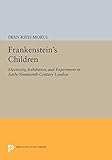Frankenstein's Children : Electricity, Exhibition, and Experiment in Early-Nineteenth-Century London / Iwan Rhys Morus.
Material type: TextSeries: Princeton Legacy Library ; 409Publisher: Princeton, NJ : Princeton University Press, [2014]Copyright date: ©1998Edition: Core TextbookDescription: 1 online resource (340 p.) : 23 halftonesContent type:
TextSeries: Princeton Legacy Library ; 409Publisher: Princeton, NJ : Princeton University Press, [2014]Copyright date: ©1998Edition: Core TextbookDescription: 1 online resource (340 p.) : 23 halftonesContent type: - 9780691605272
- 9781400847778
- 303.48/3
- QC527.5 -- M67 1998eb
- online - DeGruyter
- Issued also in print.
| Item type | Current library | Call number | URL | Status | Notes | Barcode | |
|---|---|---|---|---|---|---|---|
 eBook
eBook
|
Biblioteca "Angelicum" Pont. Univ. S.Tommaso d'Aquino Nuvola online | online - DeGruyter (Browse shelf(Opens below)) | Online access | Not for loan (Accesso limitato) | Accesso per gli utenti autorizzati / Access for authorized users | (dgr)9781400847778 |
Browsing Biblioteca "Angelicum" Pont. Univ. S.Tommaso d'Aquino shelves, Shelving location: Nuvola online Close shelf browser (Hides shelf browser)

|

|

|

|

|

|

|
||
| online - DeGruyter Science, Jews, and Secular Culture : Studies in Mid-Twentieth-Century American Intellectual History / | online - DeGruyter Making Peace with the 60s / | online - DeGruyter The Albanian National Awakening / | online - DeGruyter Frankenstein's Children : Electricity, Exhibition, and Experiment in Early-Nineteenth-Century London / | online - DeGruyter The Enlightenment Bible : Translation, Scholarship, Culture / | online - DeGruyter Uncorked : The Science of Champagne - Revised Edition / | online - DeGruyter The Crooked Timber of Humanity : Chapters in the History of Ideas - Second Edition / |
Frontmatter -- CONTENTS -- LIST OF ILLUSTRATIONS -- PREFACE -- PART ONE: The Places of Experiment -- INTRODUCTION: Electricity, Experiment, and the Experimental Life -- CHAPTER 1. The Errors of a Fashionable Man: Michael Faraday and the Royal Institution -- CHAPTER 2. The Vast Laboratory of Nature: William Sturgeon and Popular Electricity -- CHAPTER 3. Blending Instruction with Amusement: London's Galleries of Practical Science -- CHAPTER 4. A Science of Experiment and Observation: The Rise and Fall of the London Electrical Society -- CHAPTER 5. The Right Arm of God: Electricity and the Experimental Production of Life -- PART TWO: Managing Machine Culture -- INTRODUCTION: From Performance to Process -- CHAPTER 6. They Have No Right to Look for Fame: The Patenting of Electricity -- CHAPTER 7. To Annihilate Time and Space: The Invention of the Telegraph -- CHAPTER 8. Under Medical Direction: The Regulation of Electrotherapy -- CODA: The Disciplining of Experimental Life -- NOTES -- BIBLIOGRAPHY -- INDEX -- ABOUT THE AUTHOR
restricted access online access with authorization star
http://purl.org/coar/access_right/c_16ec
During the second quarter of the nineteenth century, Londoners were enthralled by a strange fluid called electricity. In examining this period, Iwan Morus moves beyond the conventional focus on the celebrated Michael Faraday to discuss other electrical experimenters, who aspired to spectacular public displays of their discoveries. Revealing connections among such diverse fields as scientific lecturing, laboratory research, telegraphic communication, industrial electroplating, patent conventions, and innovative medical therapies, Morus also shows how electrical culture was integrated into a new machine-dominated, consumer society. He sees the history of science as part of the history of production, and emphasizes the labor and material resources needed to make electricity work.Frankenstein's Children explains that Faraday, with his colleagues at the Royal Society and the Royal Institution, looked at science as the province of a highly trained elite, who presented their abstract picture of nature only to select groups. The book contrasts Faraday's views with those of other practitioners, to whom science was a practical, skill-based activity open to all. In venues such as the Galleries of Practical Science, electrical phenomena were presented to a public less distinguished but no less enthusiastic and curious than Faraday's audiences. William Sturgeon, for instance, emphasized building apparatus and exhibiting electrical phenomena, while chemists, instrument-makers, and popular lecturers supported the London Electrical Society. These previously little studied "electricians" contributed much to the birth of "Frankenstein's children"--the not completely benign effects of electricity on a new consumer world.Originally published in 1998.The Princeton Legacy Library uses the latest print-on-demand technology to again make available previously out-of-print books from the distinguished backlist of Princeton University Press. These editions preserve the original texts of these important books while presenting them in durable paperback and hardcover editions. The goal of the Princeton Legacy Library is to vastly increase access to the rich scholarly heritage found in the thousands of books published by Princeton University Press since its founding in 1905.
Issued also in print.
Mode of access: Internet via World Wide Web.
In English.
Description based on online resource; title from PDF title page (publisher's Web site, viewed 30. Aug 2021)


